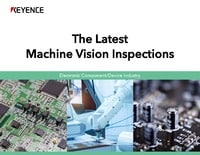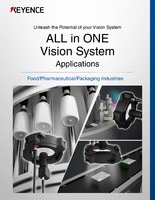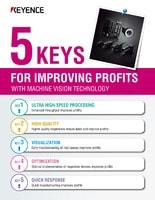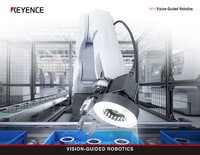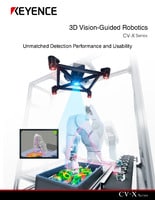3D Inspection (Volume, Height)
3D inspection (volume, height)
For appearance / dimension inspection and positioning using image processing and character recognition using OCR, targets are detected or differentiated based on the shade data of their surfaces. To increase the accuracy of these operations, various measures have been introduced including the use of high-pixel machine vision, optimization of lenses and lights, and adoption of image enhance filters and other technologies. Even with the latest technologies, it is still hard to solve certain problems in image inspection, including:
- Differentiating flaws or distortions from discoloration or color irregularity
- Detecting the depth of flaws or distortion level
- Performing pass/fail judgment based on capacity or volume
- Inspecting the profile of solder or welding
These targets are hard to detect from 2D images, so judgment depended on the human eye. Inspection using 3D images can solve these problems. This page explains 3D inspection which detects height and surface information.
Basic principle of 3D inspection which uses 3D images to achieve inspection that is impossible with 2D images
Advantages of 3D inspection
2D inspection detects or differentiates appearance or dimension based on shade data. 3D inspection uses height information (XYZ coordinates) as well. This section describes the differences between 2D and 3D images, and the advantages of introducing 3D inspection.
Differences between 2D and 3D images
- 2D Images
- 2D images are captured from one direction. They can be used to find defects on the surface of parts/products through shade adjustment with image enhance filters.
- 3D Images
- Adding height information to a 2D image makes a 3D image. Including the XYZ coordinate information makes it possible to obtain information about not just height, but also volume and sectional area.
Effects of introducing 3D inspection: stable inspection
2D inspections often suffer from unstable detection of flaws or dents depending on the color or pattern of the target, and effects of the environment such as reflections from glossy surfaces or lights. It was hard to increase the accuracy even with image enhance filters such as shading correction, blob processing, and contrast conversion. 3D inspection makes it possible to perform stable detection of minute dents and flaws that look similar to patterns on the target, which were difficult to differentiate with conventional 2D images. This allows automation of inspection.
3D inspection allows inspections using volume or sectional area information, based on height differentiation or XYZ information. This greatly expands the range of inspections possible with image processing.

Effects of 3D inspection using image processing: improved efficiency
With a 3D measurement system, anyone can conduct 3D inspection. Unfortunately, 3D measurement systems are designed for offline inspection, and it takes a lot of time to bring targets to the measurement room and measure them. This is acceptable as long as the target is a high-value-added product manufactured in low volume. However, it is impractical to conduct 100% inspection for products produced in large lots of thousands or tens of thousands per day.
With machine vision/image processing system, you can obtain 3D information inline, resulting in efficient inspection. The latest image processing systems offer processing speed fast enough for applications on high-speed lines. This allows 100% inspection without affecting takt time. This prevents outflow of defective workpieces, helping to improve quality.
Effects of introducing 3D inspection: equipment/labor cost reduction
You can automate the inspections that relied on visual or offline inspection, which reduces labor costs. A 3D camera can capture both 3D and 2D images (gray-scale images) simultaneously, reducing equipment costs.
Measurement principle of 3D inspection
KEYENCE offers two types of measurement systems for 3D inspection. The XR Series 3D camera is suitable for stopped targets and pitch-feeding lines; the LJ-V7000 Series high-speed 2D/3D laser scanner is suitable for moving targets and continuous feeding processes. Each has its own characteristic measurement principles and functions to achieve optimum 3D inspection depending on the application and target conditions.
Pattern projection
The XR Series uses the pattern projection method. It projects stripe patterns from the right and left at high speed and analyzes the reflected light with an ultra-high-speed CMOS and a special processor to generate a 3D image. Projecting patterns from two directions to synthesize profile information allows capture of images without blind spots. The XR Series can also work as an area camera to capture 2D (black and white shade) images. The ability to conduct 2D and 3D inspections simultaneously is another advantage.

Micromirror Device MEMS technology for high-speed stripe pattern generation
Hi-speed CMOS High-speed, high-sensitivity device for inline 3D measurement

LJ-V7000 Series for measurement of large areas
The measurement range of the XR Series is limited, from 15 mm square to 40 mm square (more accurately, 12.5 mm square to 35.5 mm square at the reference distance). Consequently, it is suitable for 3D inspection of relatively small parts and products such as electronic devices. If you want to conduct 3D inspection of larger areas, the LJ-V7000 Series inline 2D/3D laser scanner is ideal. You can perform 3D inspection, including height, area and volume information, by capturing high accuracy 2D profile data through the light-section method and processing it with an image processing system such as the XG-X Series. This allows 3D inspection of lengthy targets such as weld beads or of fast moving targets.

Algorithms and various software that support 3D image inspection
Various image processing technologies play a part in 3D inspection. With the XG-X Series customizable machine vision, just specifying an inspection area in a captured 3D image allows measurement of minimum height, maximum height, convex area, concave area, convex volume, and concave volume. First, specify a zero plane as a reference for height measurement. Then, measure the area or volume of a convex/concave area with reference to the zero plane.

Various other useful functions greatly improve inspection accuracy and streamline the work of setting up the system.
Practical applications
Many inspections that are impossible with 2D images are possible with 3D images. Let's look at some typical applications.
Inspection of solder fillet
It is difficult to detect the condition of solder surfaces through the surface inspection with machine vision. Electronic devices have become miniaturized and more accurate in recent years. It is difficult to make judgments visually or using machine vision. The introduction of 3D inspection makes not only height but also area and volume information available. This allows reliable inspection of solder fillet shape.



Conventional camera
Inspection was unstable due to the influence of the solder surface conditions.
XR Series
3D inspection enables inspection of height and shape without being affected by surface conditions.
Counting chocolate pieces and checking for missing pieces
3D inspection has also been introduced in the food and pharmaceutical industries. When targets do not show shade differences, like chocolate, it was hard to detect flaws or dents with conventional 2D inspection. With 3D inspection, flaws and dents can be detected reliably from height and other information. Counting is also possible, which helps improve production efficiency.

Connecting the LJ-V7000 Series 3D measurement system allows the counting targets while also checking for dents and foreign particles on the target surfaces.


Insufficient
OCR reading of card numbers
When a card has a background picture or illustration, as is often found on credit cards, detection of the card number is difficult due to the influence of the background. Since 3D inspection can recognize height, it can read the card number, expiration date and name embossed on the card surface accurately using OCR.



Conventional camera
Reading was impossible due to the influence of the background.
LJ-V Series
The measurement using height information ensures stable OCR.

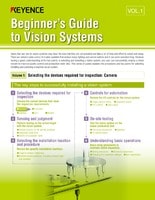

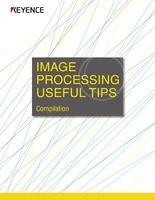
![A Technical History of Image Processing Vol.1 [Camera]](/img/asset/AS_46814_L.jpg)
![The Latest Image Processing Applications [Transportation Industry]](/img/asset/AS_71759_L.jpg)
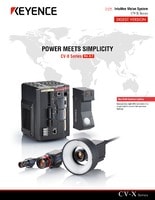
![The Latest Machine Vision Inspections [Food and Medical Industries]](/img/asset/AS_72814_L.jpg)
